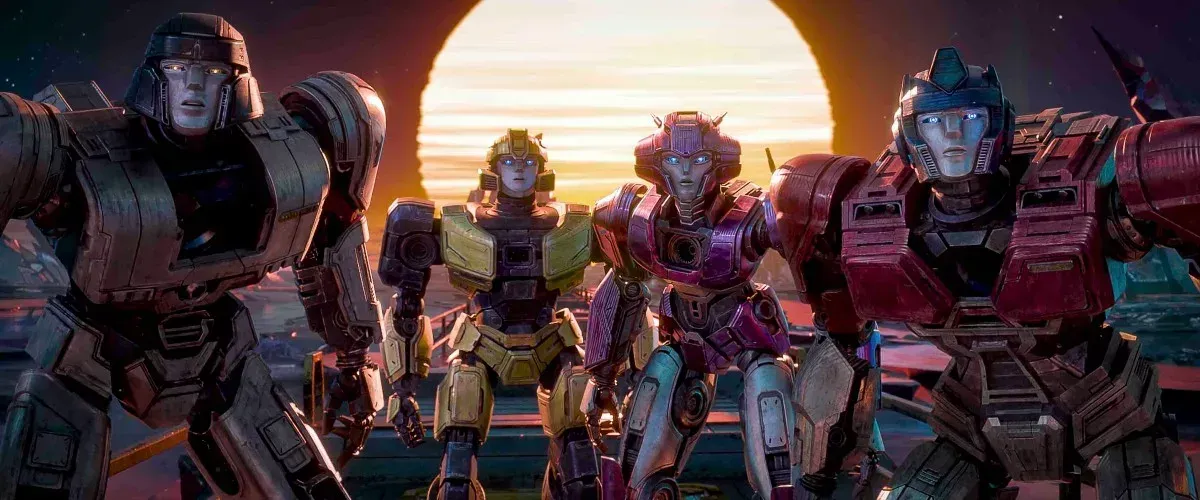Jonah Naplan September 20, 2024
I was majorly disappointed by “Transformers One,” an animated prequel to a beloved franchise that’s directed by Josh Cooley, whose work in “Toy Story 4” embodied the impressive and neared the impossible. It’s frustrating to see what little he does here with the strong emotional choices he made in that film, despite a narrative that wants to burst with imagination and deliver fans the goods and services they want and deserve. The last 20 minutes or so are excellent, capitalizing on all we’d ever need from a “Transformers” picture, but the middle section is so repetitive and boring and the first act is so misguided and unfocused that you almost forget about what really works in this movie. Yeah, yeah, the animation is creatively rendered, but that seems besides the point when it neglects to draw the viewer in on an emotional level instead of just a visual one.
“Transformers One” is ultimately a duet and sometimes a quartet between a set of characters. The two leads are Orion Pax (voice of Chris Hemsworth) and D-16 (voice of Brian Tyree Henry), best buds working as miners on the planet Cybertron whose physical and spiritual journeys will eventually turn them against each other as Optimus Prime and Megatron. But before that can happen in the movie’s last scenes, it still has much housekeeping to do. Cybertron is a sort of dichotomized utopia of two social classes: there are the upper-class “Transformers” whose t-cogs allow them to change the shape of their bodies at will, and then the inferior “worker bots” who act as slaves mining Energon, a much-coveted universal food and energy source.
Centuries prior, the planet lost its “Matrix of Leadership,” striking the inhabitants into disarray and allowing those with the will to subjugate—here it’s Sentinel Prime (voice of Jon Hamm), a near-fascist showman and dictator—to rise to power. Orion and D-16 surmise that if they personally scour the surface of their world to find this device, they’ll not only save the very fiber of their planet from falling closer and closer to its destruction, but they’ll also put themselves (and their entire social class) on the map as forces to be reckoned with and heard in a reality that’s constantly trying to push them down. Along for the ride are fellow worker bots B-127 (voice of Keegan-Michael Key) and Elita (voice of Scarlett Johansson), a dynamic that never really evolves beyond the surface level of thin one-liners on Key’s part and stern disapproval from Johansson.
The middle section of “Transformers One” is near insufferable as it trots out and repeats the same clichés and thematic ideas over and over again. The biggest point of frustration is that this is also where the film wants to unpack not only its narrative turning point but the major character shifts in mentality and motivation. Those who pay close enough attention may appreciate the slow-burning attempt to have D-16 steadily evolve from a cautious nobody to a revenge-fueled agent of destruction over the course of the movie, but will be equally frustrated by the film’s reluctance to take that arc anywhere more profound, especially when there’s lots of big-robot-fighting to do in the meantime.
The voice acting is mostly indistinguishable. Unlike the work of Pixar, Dreamworks, and a good portion of Illumination, “Transformers One” doesn’t use its celebrity talents to its credit other than simply having an impressive name and a face that you might recognize on a Google cast list. Hemsworth is simply not right for the role of an emerging Optimus Prime, and I’m beckoned to think that he’s somehow both too old and too young. Side performances from Hamm and Steve Buscemi as a pernicious run-in named Starscream are so indistinct that you can imagine them recording all their lines in one sitting and then leaving the studio, paycheck in hand. The best of the bunch is Henry, who infuses his character with a complex vulnerability that the movie can’t seem to handle. You can see where he knew the character needed to go, and each of his line deliveries flags his progress towards that metaphysical destination. If only the movie weren’t so intentional about distracting from the bigger, intellectual picture, we might have had a new classic of villainy origins in the echoes of “Star Wars: Revenge of the Sith” and “X-Men: First Class.”
Of course, there’s panache in the movie’s visual outlook, but its over-reliance on the crashes and bangs leads to exhaustion rather than adrenaline. There’s a feeling throughout that “Transformers One” is trying to appeal to as many different demographics as possible; the corny jokes and frenetic nature of the whole thing are entirely unironic elements intended for the engagement of children, while its level of (relative) maturity might be a brief breath of fresh air for adults tired of Minions. Ultimately, though, it’s just a headache, which may have been a byproduct of the 3D screening I attended, but I have to imagine it’s not that much better in standard display.
Yes, we’re still working at a higher level of quality here than what Michael Bay did with this franchise for ten years, but even if “Transformers One” takes a slight creative departure by being animated instead of live-action like its brethren, I saw no proof of innovation or potency in the decision. You might expect this change to offer itself over to a degree of artful expression you simply cannot telegraph in a live-action movie, but whatever high pedestal you’re searching for won’t be found here. What could have been a footprint in the snow of a genre constantly evolving and reshaping itself to continuously raise the proverbial bar higher and higher is instead an emotionally and intellectually empty exercise lacking the grit to transform into anything memorable.
Now playing in theaters.

